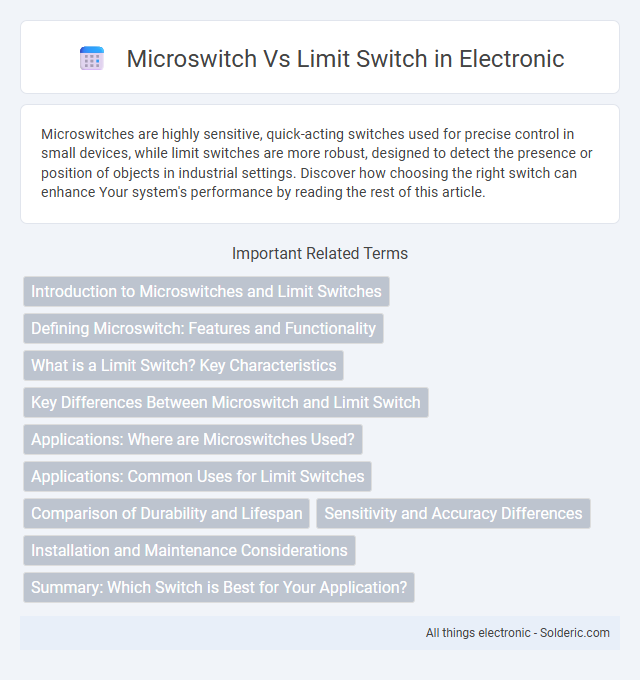Microswitches are highly sensitive, quick-acting switches used for precise control in small devices, while limit switches are more robust, designed to detect the presence or position of objects in industrial settings. Discover how choosing the right switch can enhance Your system's performance by reading the rest of this article.
Comparison Table
| Feature | Microswitch | Limit Switch |
|---|---|---|
| Definition | Small, sensitive switch activated by minimal force or movement. | Switch designed to detect the presence or position of a moving object. |
| Operation | Triggered by a precise mechanical actuator like a lever or button. | Activated by physical contact with an object reaching a set limit point. |
| Size | Compact and lightweight. | Usually larger to withstand heavy-duty environments. |
| Sensitivity | Highly sensitive to small force; operates instantly. | Less sensitive; designed for reliability at end-of-travel positions. |
| Typical Use | Precision control in control panels, appliances, and electronic devices. | Industrial machinery for position control and safety limits. |
| Durability | Moderate; suitable for frequent low-force activations. | Highly durable; built for tough industrial conditions. |
| Contact Rating | Lower current and voltage capacity. | Higher current and voltage handling capability. |
Introduction to Microswitches and Limit Switches
Microswitches are compact, highly sensitive switches designed to actuate with minimal physical force, commonly used in precision equipment. Limit switches serve as safety devices that detect the presence or position of an object, often employed in industrial machinery to control movement and prevent damage. Understanding the distinct applications and operational mechanisms of microswitches and limit switches can optimize your control system's performance and reliability.
Defining Microswitch: Features and Functionality
A microswitch is a highly sensitive, compact switch designed for precise, rapid activation with minimal physical force, often employing a small internal lever or button mechanism. It features a snap-action mechanism that ensures reliable operation in applications requiring quick on/off signals, such as safety devices, appliances, and control systems. Its durability and consistent performance under repeated stress make it ideal for detecting position, presence, or mechanical movement within automated processes.
What is a Limit Switch? Key Characteristics
A limit switch is an electromechanical device used to detect the physical presence or position of an object by making or breaking an electrical connection. Key characteristics include its ability to handle high current loads, resist mechanical wear with robust construction, and provide precise repeatability in motion control systems. Your automation or safety systems benefit from limit switches due to their reliable performance in harsh environments and straightforward integration.
Key Differences Between Microswitch and Limit Switch
Microswitches and limit switches differ primarily in their applications and mechanical design; microswitches are known for their small size, high sensitivity, and precise actuation often used in control circuits, while limit switches are typically larger, designed to detect the presence or position of objects in industrial environments. The key functional distinction lies in their actuation mechanisms--microswitches utilize a snap-action mechanism for rapid switching, whereas limit switches employ a lever or plunger to trigger contacts based on physical movement. Understanding these differences helps you select the appropriate switch type to ensure reliable performance in your automation or safety control systems.
Applications: Where are Microswitches Used?
Microswitches are widely used in applications requiring precise, quick response detection such as microwave ovens, vending machines, and safety interlocks in industrial equipment. Their reliability and durability make them ideal for automotive systems, home appliances, and HVAC controls. Your choice to use a microswitch ensures accurate actuation in environments demanding high sensitivity and frequent operation.
Applications: Common Uses for Limit Switches
Limit switches find extensive use in industrial automation for detecting the presence or position of objects, ensuring machinery safety by controlling movement limits, and operating conveyor systems. They are commonly integrated into manufacturing equipment, elevators, and robotic arms to provide precise mechanical feedback and automatic shut-off functions. These switches are essential in packaging, assembly lines, and material handling processes where accurate position detection prevents damage and maintains workflow efficiency.
Comparison of Durability and Lifespan
Microswitches generally offer higher durability due to their sealed design, protecting internal components from dust, dirt, and moisture, which extends their lifespan in harsh environments. Limit switches, while robust, often have mechanical parts exposed, making them more susceptible to wear and requiring more frequent maintenance. Your choice should consider the operating environment and required maintenance frequency to ensure optimal switch performance and longevity.
Sensitivity and Accuracy Differences
Microswitches offer higher sensitivity due to their low actuation force and precise snap-action mechanism, making them ideal for applications requiring rapid response and accuracy at low thresholds. Limit switches, while reliable, generally provide less sensitivity as they are designed for detecting the physical position of moving parts with larger actuation forces. The accuracy of microswitches in detecting small changes surpasses that of standard limit switches, which excel at robust position detection rather than fine sensitivity.
Installation and Maintenance Considerations
Microswitches are known for their compact design and straightforward installation, making them ideal for applications with limited space, while limit switches typically require more robust mounting due to their larger size and industrial use. Maintenance of microswitches involves less frequent adjustments because of their precise internal mechanisms, whereas limit switches often need regular inspection and calibration to handle heavy-duty operations and environmental factors. Choosing the right switch directly influences your system's reliability and maintenance schedule, ensuring optimal performance in your installation.
Summary: Which Switch is Best for Your Application?
Microswitches provide precise, reliable actuation with fast response times, ideal for low-force, high-frequency applications such as home appliances and control panels. Limit switches offer robust performance for heavy-duty environments, capable of handling higher loads and more extreme conditions, making them suitable for industrial machinery and automated systems. Choose a microswitch when accuracy and compact design are priorities, but select a limit switch for durability and handling mechanical limits in demanding applications.
microswitch vs limit switch Infographic

 solderic.com
solderic.com